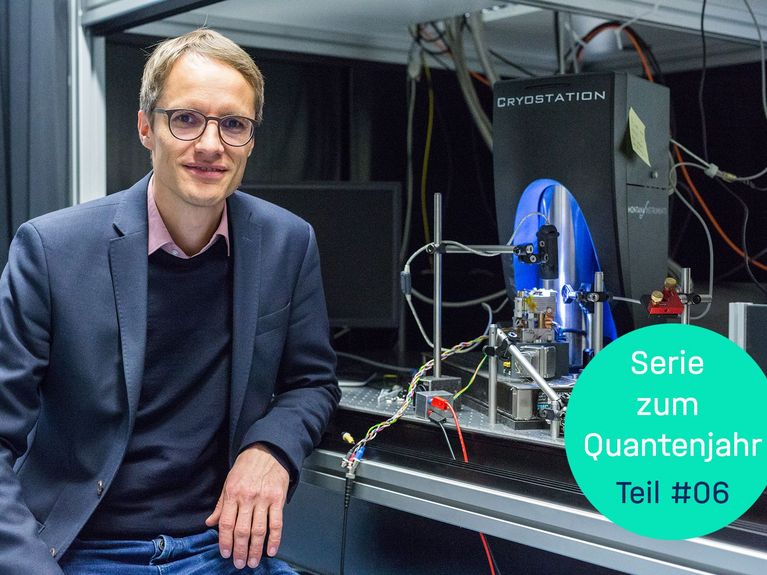Series in the quantum year 2025
Part #06: Tap-proof quantum communication

We spoke with physicist David Hunger from the Karlsruhe Institute of Technology (KIT) about quantum communication that cannot be eavesdropped on unnoticed thanks to quantum particles.
100 years ago, the pioneers of quantum mechanics were able to show that there is real chance in nature and that objects on a microscopic scale cannot be described in the same way as we are used to in our everyday lives. This coincidence is expressed in Heisenberg’s uncertainty principle, according to which it is not possible to bring quantum objects into a state in which their location and momentum can be determined simultaneously with arbitrary precision. However, quantum mechanics has not only given us a deeper understanding of what happens in the microcosm, but also offers us a range of extraordinary fields of application: from quantum materials with extraordinary properties, such as topological superconductors, to quantum computers and quantum communication. In the following, we will shed some light on what the latter is all about:
“Quantum communication is about tap-proof communication between a sender and a receiver,” explains quantum physicist David Hunger from KIT. “It is based on the fundamental quantum mechanical principle that a quantum state cannot be copied […].” Communication takes place via light signals that run in fiber optic cables from a transmitter to a receiver. “Communication by light via fiber optic cables is nothing new in itself,” says Hunger. “In contrast to conventional communication structures, however, we don’t use classic light pulses in quantum communication, but individual light particles, i.e. photons.” The photons are encoded and the actual information is transmitted in individual quanta and their quantum states.
“Now, unauthorized eavesdropping by third parties inevitably leads to measurable errors in the transmission of information, which indicate to the recipient that an eavesdropping attempt has taken place.” Like a letter seal that has to be broken in order to open the envelope and read the document hidden inside. The prerequisite for tap-proof quantum communication is that the receiver and sender agree again after the information has been transmitted as to whether there has been any interference with the quantum signal in the form of measurable anomalies,” explains David Hunger. “And this is exactly what shows up as an increased error rate or noise rate in the signal. Communication must then be interrupted and countermeasures taken.” For these reasons, quantum communication is already being used successfully in security-critical and data protection-relevant areas of government authorities and in the financial sector.
“But the associated quantum technologies are still very expensive and resource-intensive,” admits Hunger. “Accordingly, research is focusing on the miniaturization of technical components on the one hand, and on more efficient quantum coding systems such as […]variable quantum key distribution on the other.” In this […] quantum key distribution (QKD), the information is transferred as a cryptographic protocol to individual photons using strongly attenuated laser pulses. “Another technical challenge is the natural attenuation of the light signals over long distances,” says David Hunger. After 100 kilometers, around 99 percent of the signal is lost. The quantum repeater provides a remedy here. “However, this is not an amplifier in the sense that a quantum state cannot be simply copied and amplified […].”
Instead, the quantum repeater uses another concept, entanglement, which is buffered in quantum memories at intermediate stations along the transmission path. “These are systems that can record quantum states of light and store them for a certain period of time, so that interlocking between neighboring repeater stations can be generated in individual route segments.” In entanglement, two quantum memories are brought into a shared state that is more strongly correlated than any conceivable classical state. In a further step, the entangled individual segments are linked by entanglement swapping so that the sender and receiver ultimately obtain an entangled state. […] The sender and receiver are then in a quantum mechanical correlation, regardless of the distance between them. Interception of the line is inevitably associated with a measurement and freezing of the quantum state of the signal, which destroys quantum entanglement. The actual and undisturbed transmission of the quantum mechanical state of the photon to the next repeater and finally to the receiver is called quantum teleportation. “In principle, using that technique any distance can be overcome in this way,” explains David Hunger.
David Hunger is currently working and experimenting with his working group and his collaboration partners on a KIT fiber optic test track between the South Campus in Karlsruhe and the North Campus of the research center near Eggenstein-Leopoldshafen, more than ten kilometers away. “We are already successfully exchanging quantum signals between the two locations on this test track, which allows us to research quantum key distribution under real environmental conditions.” According to David Hunger, they are working to take the next step towards real quantum internet: Tap-proof long-distance quantum communication to link quantum computers. A dream of the future, however, the first sounds of which can already be heard.
Readers comments